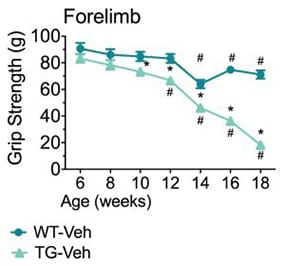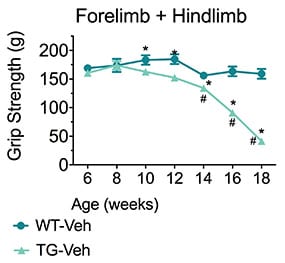Grip Strength
Discover how Melior’s unique phenotypic screening platforms can uncover the untapped value of your candidate therapeutic
Rats or mice are placed on a wire grid with either forelimbs alone or forelimb + hindlimb gripping the grid, pulled backwards by the tail, and the maximal force the animal exerts at the time of release is recorded.
This test is a simple and reliable measure of the function of the general motor capability of the animal, in particular, the function of the spinal motor neurons, efferent axonal conduction, neuromuscular junction, and the muscles themselves. It is customarily included as an endpoint is Spinal Muscular Atrophy model (SMA Model) studies as well as Amyotrophic Lateral Sclerosis model (ALS Model) studies.
Ready to get started or looking for a custom model?
Contact us today for more information about our bespoke research models and to discuss how we can help you answer your unique research questions.


Grip Strength (grams) in SOD G93A transgenic mice, a well-characterized model of ALS, from 6-18 weeks of age. The initial decrease in strength in both transgenic (TG-Veh) and wild type (non-carrier; WT-Veh) mice is not unusual. It is, however, typical for the transgenic mice to be slightly reduced in strength from the outset of the study. After 14 weeks, the transgenic mice show a significant rapid loss in muscle strength, whereas grip strength in the wild type mice is maintained. Data are mean ± SEM; *p<0.05 compared to wild type mice.
Grip Strength is an assay that can typically be performed in one day for an entire experimental cohort of animals. Because it is non-invasive it can easily be repeated several times over the course of a chronic study.

 Interested in running a Grip Strength study?
Interested in running a Grip Strength study?